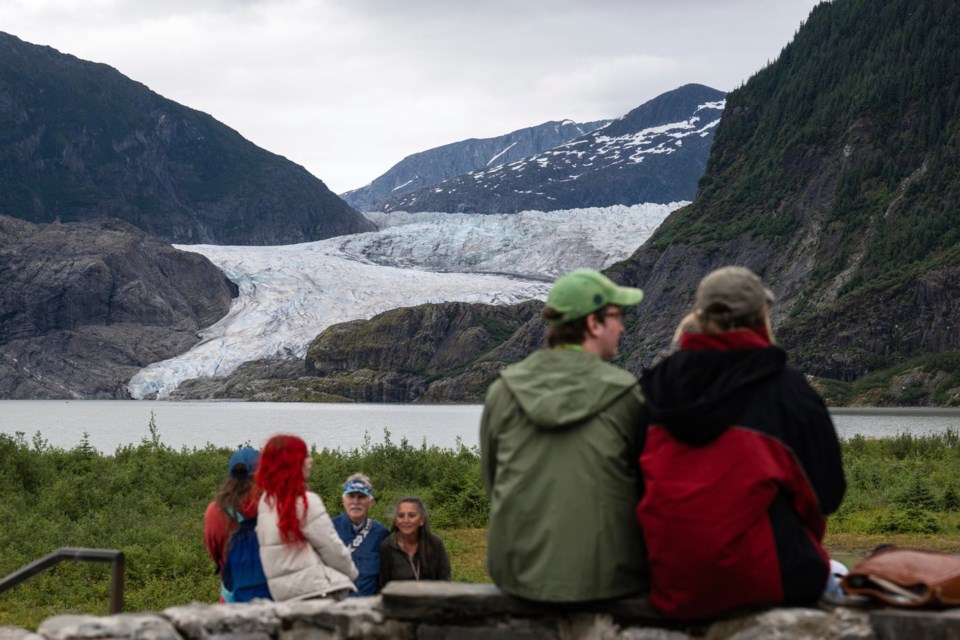Sections of Alaska's capital city are bracing for the arrival of what could be record floodwaters due to rainwater and snowmelt flowing downstream from a basin dammed by the Mendenhall Glacier.
Some Juneau residents in the flood zone have evacuated, heeding warnings. On Tuesday morning, authorities confirmed water had started escaping the ice dam, with flooding expected into Wednesday.
The Mendenhall Glacier is about 12 miles (19 kilometers) from Juneau, home to 30,000 people, and is a popular tourist attraction due to its proximity to Alaska’s capital city and easy access on walking trails. Homes on the city’s outskirts are within miles of Mendenhall Lake, which sits below the glacier, and many front the Mendenhall River, into which the glacial outburst is flowing.
The National Weather Service said it expected flooding to to peak around 8 a.m. to noon on Wednesday.
“This will be a new record, based on all of the information that we have,” Nicole Ferrin, a weather service meteorologist, told a news conference Tuesday.
Basin flooding is a yearly worry
Flooding from the basin has become an annual concern since 2011, and in recent years has swept away houses and swamped hundreds of homes. Government agencies installed temporary barriers this year in hopes of protecting several hundred homes in the inundation area from widespread damage.
The flooding happens because a smaller glacier near Mendenhall Glacier retreated — a casualty of the warming climate — and left a basin that fills with rainwater and snowmelt each spring and summer. When the water creates enough pressure, it forces its way under or around the ice dam created by the Mendenhall Glacier, enters Mendenhall Lake and eventually flows down the Mendenhall River, as it did Tuesday.
Before the basin began overtopping, the water level was rising rapidly — as much as 4 feet (1.22 meters) per day during especially sunny or rainy days, according to the National Weather Service.
The city saw successive years of record flooding in 2023 and 2024 — with the river last August cresting at 15.99 feet (4.9 meters), about 1 foot (30 centimeters) over the prior record set a year earlier — and flooding extending farther into the Mendenhall Valley. This year's flooding was predicted to crest at between 16.3 and 16.8 feet (4.96 to 5.12 meters).
Last year, nearly 300 residences were damaged.
A large outburst can release some 15 billion gallons of water, according to the University of Alaska Southeast and Alaska Climate Adaptation Science Center. That’s the equivalent of nearly 23,000 Olympic-size swimming pools. During last year’s flood, the flow rate in the rushing Mendenhall River was about half that of Niagara Falls, the researchers say.
A temporary levee is installed
City officials responded to concerns from property owners this year by working with state, federal and tribal entities to install a temporary levee along roughly 2.5 miles (4 kilometers) of riverbank in an attempt to guard against widespread flooding. The 10,000 “Hesco” barriers are essentially giant sandbags intended to protect more than 460 properties completely during an 18-foot (5.5-meter) flood event, said emergency manager Ryan O’Shaughnessy.
The U.S. Army Corps of Engineers is at the start of what’s expected to be a yearslong process of studying conditions in the region and examining options for a more permanent solution, such as a levee. The timeline has angered some residents, who say it’s unreasonable.
Outburst floods are expected to continue as long as the Mendenhall Glacier acts as an ice dam to seal off the basin, which could span another 25 to 60 years, according to the university and science center researchers.
___
Associated Press writer Becky Bohrer in Juneau contributed to this report.
Cedar Attanasio, The Associated Press


